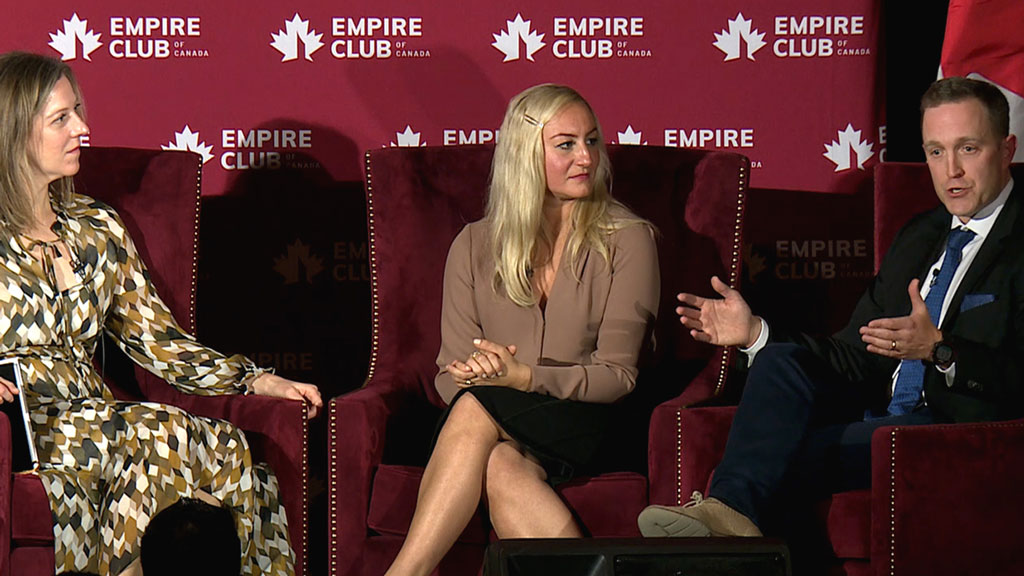Collaborative procurement, contract and delivery models and the management of risk dominated the discussion at a recent Empire Club of Canada event billed Update on the Status of Infrastructure: Building Ontario.
Ontario’s Minister of Infrastructure Kinga Surma and Infrastructure Ontario CEO Michael Lindsay addressed the crowd which gathered in person at the Royal York in Toronto. The Q&A session was moderated by Kelly Jackson, past board president and board director of the Empire Club of Canada.
Increases in shipping and material costs, high inflation, market volatility, a labour market crisis and new consumption patterns have caused infrastructure projects to face significant barriers, said Surma.
“We cannot ignore these challenges and the current reality,” she noted. “The labour shortages, stressed supply chains and economic uncertainty that are seen and felt worldwide require a response. They are prompting us to become even more innovative when building.”
New and innovative delivery models such as accelerated build and progressive procurement approaches are required to respond to changing market conditions.
“The development of progressive procurements has allowed Ontario to maintain competitive bid environments on complex projects by working with project co’s to more accurately price input costs and risk premiums,” she added.
During his address, Lindsay made four commitments, one of which focused on risk management.
“We’re going to continue to be as sophisticated as we possibly can in respect of the management of risk,” said Lindsay. “First and foremost, we’re going to continue to work with this government who, under their leadership, has actually done much to eliminate some of the risks associated with major projects.”
He also committed to working with the market to get a better understanding of the risks.
“I promise you, we are going to work together, Infrastructure Ontario and our market, to better understand risks like hyper-inflation, geotechnical conditions, what is a fair assignation of those risks, as between parties, the best way to have contingency for them and the best way to mitigate them collectively moving forward,” he noted.
“Much of what we’ve done about adopting progressive forms of delivery is all with an eye to try to create space and time for us and our market to have thoughtful conversations across these dimensions.”
He said there are three things in particular that are part of the recipe for success.
“Number one, we have taken a step on some of our projects in thinking about the packaging of those works and the extent to which the thoughtful disaggregation of some of our projects, particularly in the transit space create not only, for lack of a better word, digestible projects for our market, but also intentionally allow a counterparty to manage risks which they know that they can,” said Lindsay.
“Tunnelling is an excellent example of precisely that. I think the market responded really well to the decision ultimately to create several separate tunnelling tenders for our transit projects.”
Secondly, within existing contract structures Lindsay said they have tried to learn from the lessons of the last 10 to 15 years about the kinds of risks that have posed problems for major projects.
“Whether it’s permits, licenses and approvals or geotechnical risk, we’ve been working with the industry to think about, frankly, how we create new ways of trying to identify, quantify and mitigate those risks on an ongoing basis,” said Lindsay.
Third is the adoption of a more progressive form of project definition and design.
“It’s another very intentional step that we’ve taken to create a space, before we fix the price for work, to work with a competitively selected counterparty to ultimately define what not only the cost of work is going to be but also what the quality of that work is going to be and how we think about managing risk in the eventual contract that we sign,” said Lindsay.
Surma and Lindsay were asked what are they doing to attract new construction partners that may have more collaborative procurement experience to the province.
“The key way we were trying to attract people with those capabilities is by actually doing collaborative procurement and contracting which is happening from alliancing down at Union Station to progressive DB which we are doing in connection to the Scarborough Subway Extension,” he said.
He added talking to the market about the “right tool” for any given job is important because it’s not always the same.
From the government’s perspective, Surma said they want to “get out of the way as much as possible.”
“We are always looking for ways that we can remove duplicative or unnecessary processes that are so burdensome and time consuming,” she said.
Follow the author on Twitter @DCN_Angela.











Recent Comments
comments for this post are closed